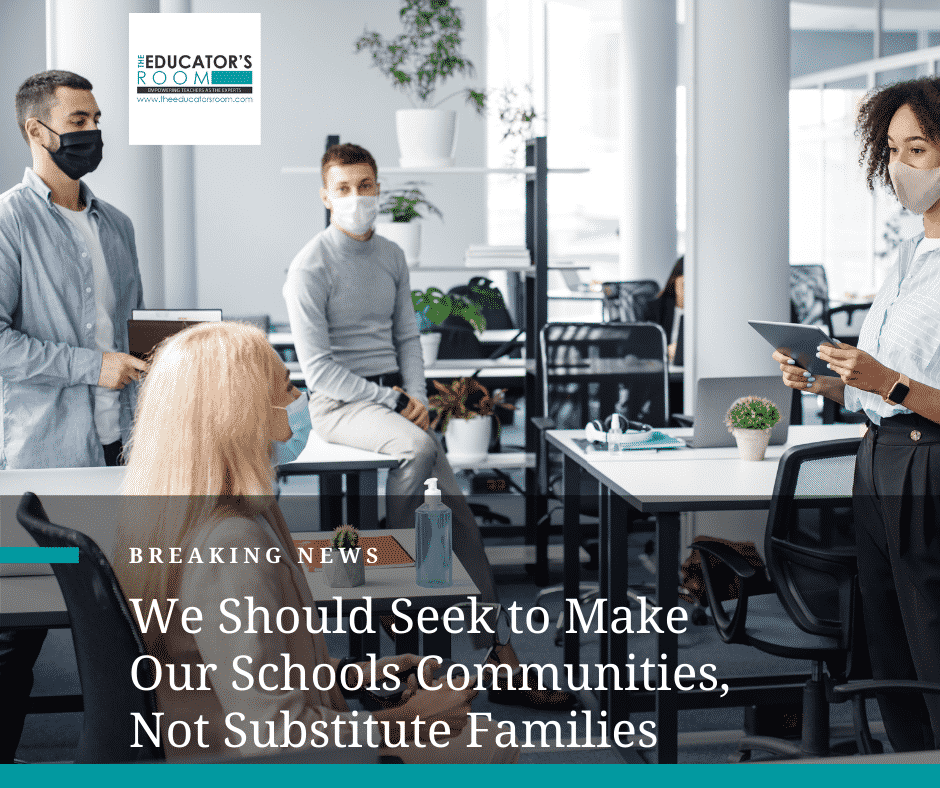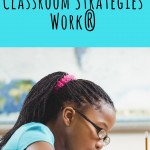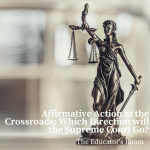“Our school is just like a family.”
Nearly every teacher has heard that phrase spoken at interviews or meetings, the comparison of the collective body of faculty, staff, and students to a close-knit family unit. While it is a common sentiment in small schools, I’ve heard plenty of teachers discuss how even their larger schools boast of a family-like environment in their communities.
A “family-like” atmosphere seems to be the goal of a lot of businesses and organizations. Shakespeare introduced the concept of a “band of brothers” in the military in his Henry V “Feast of Crispian” speech. We hear professional teams talk about being a family. Every yearbook adviser has had to fight to get teams and organizations to use something better than “family” to describe their group dynamic. And as a former high school theatre director, I will confess that we often described our program as a family, some of my thespians developing true sibling-like relationships while I regularly referred to them as “my kids.”
The truth is, most organizations have, at one time or another, sought to make themselves function more like a family. And while the metaphor of a family-like school environment may seem both nurturing and enticing for students and faculty alike, it ignores the reality that “family” is often a toxic image for many individuals in educational settings.
We have students coming to us from family situations that are complicated, at best, and harmful, at worst. Their concept of family is already skewed and they struggle to trust anyone who wants to create those artificial bonds. We have teachers and administrators with their own family-related baggage, complicating the way they feel about their jobs and their role in the school hierarchy.
In the most ideal of circumstances, families are wonderful units that raise us, support us, and are there for us when no one else is. A family bond can be the closest relationship we will ever have. There is a reason why people refer to their best friends as “brother from another mother” or “sister from another mister.” We often prize family relationships above all others. We will do anything for our families because it solidifies our place.
But the opposite can also be true. Families can be notoriously difficult to break into. We can’t fully leave our families behind, and if we do try to leave, or are forced out, we often lose those family connections forever. Families, whether we are born into them or adopted, are a part of our DNA. They make up who we are. When we are separated from them, we start to miss pieces of ourselves. And despite the bonds that are supposed to be there forever, families are not places for the diversity of thought or deviations from the “norm.” There is a reason we call outliers the “black sheep”; those who don’t fit the way everyone else expects them to will find themselves on the outside looking in.
While the concept of family is supposed to be nurturing and comforting to everyone involved, it can often have the opposite effect, causing inadvertent problems in how a school operates and the relationships that are developing inside and outside of the building.
Children with difficult family relationships, many of whom desperately need a caring adult in their lives, will be hindered by the yearly change in teachers and teacher aides. Schools that start small and nearly outgrow buildings suddenly lose their identity as they try to grapple with the loss of that “family-like atmosphere.” School employees with their own family issues struggle to see where they fit into a hierarchical structure intent on maintaining a family dynamic.
This concept carries over into the language of how schools function. School assemblies covering important details suddenly become “family meetings.” Decisions are made for the “good of the family” at the expense of individuals. Finances are referred to as the “family budget,” as if the vast majority of the people in the building have any say in how those funds are actually spent.
What if we abolished the term “family” from our school and work environments, and instead started emphasizing the concept of community? What if we didn’t just talk about our school communities as another word for group or organization, but instead started actually working to make their communities in every way?
After all, if schools are to be the building block of a strong republic (and I argue that they should be), our students should be discovering their community role and learning how to live with others in the community, not discovering another “family” that competes for their love and attention. Communities that benefit most citizens thrive when they embrace the diversity of thought and experience. Yes, there is competition in our communities as people seek success in their chosen fields and businesses, but a healthy community also understands the importance of lifting people up and helping each other reach our individual goals. A healthy community understands that people may leave when they achieve success and it will welcome in others that will help the whole community better reach its collective goals. Healthy communities, even healthy school communities, are not threatened by change and growth; they welcome it.
Certainly, families should be a part of a school community. We want parents involved who develop strong working relationships with their children’s teachers. We want students to feel safe and so we try to make our classrooms comfortable and “homey.” The children of teachers grow up coming with their parents to school as they set up classrooms and run into the building to do just “one more thing.” Some of my best childhood memories revolved around playing with other faculty kids during football and basketball games and during faculty gatherings and my own children have grown up playing in my classroom and the classrooms of my coworkers.
But as we carefully look at the many problems plaguing our school systems after two years of pandemic education, let us look to community building to be part of the solution. Let us train our teachers and administrators to be effective leaders training the next generation of citizens to be leaders in their communities outside of our school buildings. Let us seek thriving communities inside and outside of our classrooms and schools.
This change in perspective won’t revolutionize education, but maybe it will help us articulate why we need changes and how to go about making them.






This is so important! Thank you! Additionally, we don’t act like family, really. Once a new school year starts, our focus shifts to a whole new group and we don’t follow up with many people like we might with family. And that can hurt students when they learn that!